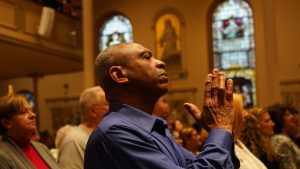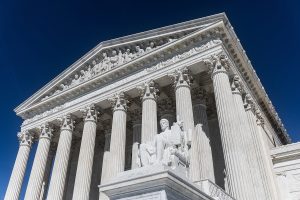
SCRANTON — More than any other day of the liturgical year, the Tuesday of Holy Week spiritually draws the hearts and souls of faithful throughout the Diocese of Scranton to the solemn setting of the Cathedral of Saint Peter in downtown Scranton for the celebration of the Pontifical Mass of the Sacred Chrism.
On Tuesday afternoon, March 26, as principal celebrant and homilist for the venerable gathering, the Most Rev. Joseph C. Bambera, Bishop of Scranton, once again warmly welcomed to the Mother Church of the Diocese the throng of worshippers of all ages who came from the four corners of the 11-county Scranton See to take part in the annual Eucharistic liturgy, so richly concelebrated by the priests serving the Diocese in northeastern and north central Pennsylvania.
The traditional Holy Week observance and gathering of the priests of the Diocese — customarily the largest of its kind each year — celebrates their clerical brotherhood and shared divine vocation.
During the Mass, priests and deacons, along with lay representatives from Diocesan parishes, acknowledge the Bishop’s role as the unifying symbol for Church governance and pastoral guidance.

All of the priests also recommit themselves to their office by renewing the promises they made on the day of their ordination to the priesthood, including their vow of obedience to the Bishop.
“I love coming to this gathering,” said Father John Chmil, pastor of Saint Elizabeth Ann Seton Parish in Swoyersville. “I especially look forward every year to renewing my priestly vows and promises, and the commitment to serve God’s people.”
Echoing similar sentiments was Father Gus Ricciardi, who serves as pastor of Old Forge’s Prince of Peace Parish.
“This Chrism Mass is a wonderful opportunity for us as fellow priests to get together not only for the camaraderie, but in fraternal community to renew our vows in support of each other and with the support of the Bishop,” Father Ricciardi commented.
Holding to ancient tradition, the Mass of the Sacred Chrism is highlighted by the blessing of the Holy Oils used during the conferral of sacraments throughout the Church year. They include the Oil of the Sick, and the Oil of Catechumens, which are used in the celebration of Baptism, Confirmation, Holy Orders, the Anointing of the Sick, and the Rites of the Catechumenate.

Father Bob Simon, pastor of Our Lady Queen of Peace Parish, Brodheadsville, described the annual Chrism Mass gathering as a “beautiful time for our priests, deacons, and religious brothers to celebrate our ministry in the company of our Bishop.”
He further expressed, “It is also so special because you reflect and think about all the people who will be anointed during the coming year with the sacred oils that will be blessed here tonight.”
Bishop Bambera began his homily by referring to the day’s Chrism Mass as a sign of the unity of God’s people with their bishop and a time when the Church calls everyone to engage in the journey of the sacramental life it offers to all believers.
“Beginning with our first encounter with the Lord at Baptism and continuing with Confirmation, Holy Orders and the Anointing of the Sick, right up to the moment when we prepare for our final journey to meet the Lord, through the use of sacred oils that we bless this day, God’s merciful love is poured forth into our lives,” Bishop Bambera stated.
Addressing his brother priests directly, the Scranton Bishop offered, “Brothers, I thank you for engaging in the hard work of priestly ministry in these challenging times — times that demand a great deal from each of us as we discern how best to continue to serve our people and parishes.”
“Without a doubt, we are richly blessed with generous seminarians who join us today, as well as the presence of so many international priests who minister among us apart from their families, home dioceses and religious communities,” he added.
In his concluding remarks, Bishop Bambera spoke to the faithful of the Diocese of Scranton by saying, “To all my brothers and sisters who make up this local Church, thank you for living your baptism, for embracing the values of the Gospel and for doing your part in building up God’s Kingdom.”









